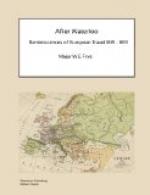[16] Not before half past eleven.—ED.
[17] John Drinkwater, also called Bethune (1762-1844),
published a
well-known History of the
Siege of Gibraltar, 1779-1783.—ED.
CHAPTER II
From Bruxelles to Liege—A priest’s declamation against the French Revolution—Maastricht—Aix-la-Chapelle—Imperial relics—Napoleon regretted—Klingmann’s “Faust”—A Tyrolese beauty—Cologne—Difficulties about a passport—The Cathedral—King-craft and priest-craft—The Rhine—Bonn and Godesberg—Goethe’s “Goetz von Berlichingen”—The Seven Mountains—German women—Andernach—Ehrenbreitstein—German hatred against France—Coblentz—Intrigues of the Bourbon princes in Coblentz—Mayence— Bieberich—Conduct of the Allies towards Napoleon—Frankfort on the Mayn—An anecdote about Lord Stewart and Lafayette—German poetry—The question of Alsace and Lorraine—Return to Bruxelles—Napoleon’s surrender.
LIEGE, June 26.
Mr L. and myself started together in the diligence from Bruxelles at seven o’clock in the evening of the 24th inst. and arrived here yesterday morning at twelve o’clock. I experienced considerable difficulty in procuring a passport to quit Bruxelles, my name having been included in that of General Wilson, which he carried back with him to England. Our Ambassador was absent, and I was bandied about from bureau to bureau without success; so that I began at last to think that I should be necessitated to remain at Bruxelles all my life, when fortunately it occurred to Mr L. that he was intimately acquainted with the English Consul, and he kindly undertook to procure me one and succeeded. On arrival here we put up at the Pommelette d’Or. The price of a place in the diligence from Bruxelles to Liege is fifteen franks. We passed thro’ Louvain, but too late to see anything. The country about Liege is extremely striking and picturesque; the river Meuse flows thro’ the city, and the banks of the river outside the town are very riants and agreeable. Liege is a large, well-built city, but rather gloomy as to its appearance, and lies in a hollow completely surrounded by lofty hills. The remains of its ancient citadel stand on a height which completely commands the city; on another height stands a monastery, a magnificent building. There are a great many coal-pits in the vicinity of Liege, and a great commerce of coals is carried on between this city and Holland by the treckschuyte on the Meuse. We visited the ancient Episcopal palace and the Churches. The Palace is completely dismantled. This city suffered much during the revolt of the Belgian provinces against the Emperor Joseph II, and having distinguished itself by the obstinacy of its defence, it was treated with great rigour by the Austrian Government. The fortifications were blown up, and nothing now remains on the site of the old citadel but a large barrack.




